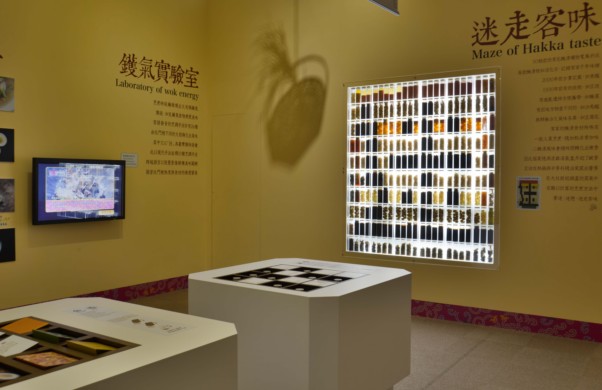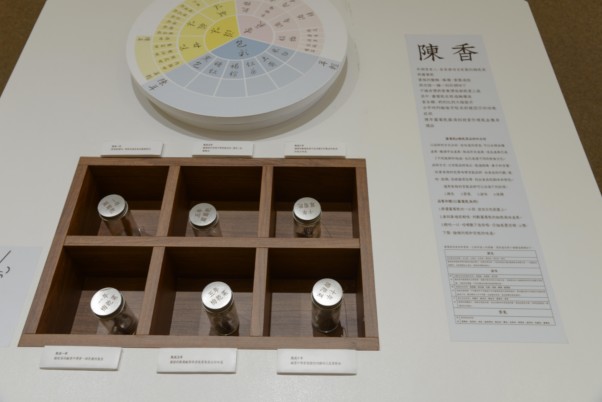展覽回顧
品客美味-臺灣客家飲食文化特展
2nd Special Exhibition Hall (Tasting Hakka dishes - Taiwan Pavilion)Tasting Hakka dishes – Taiwan’s Hakka culinary culture exhibitionDownloading exhibition brochures Taiwan’s Hakka cuisine shares with you an extraordinary deep emotion with the land The food named “snow pellets” that Hakka people in Taiwan prepare today is in fact no different from the "rice balls" prepared in the royal palace of Tang Dynasty for the Dragon Boat Festival 1200 years ago, according to the description of “Kaiyuan Tempo Heritage.” Although Hakka ancestors moved from mainland China to Taiwan 400 years ago, they have still kept many of the traditional food recipes from thousands of years ago. However, the Hakka cuisine is inadvertently quite in line with international best dietary trend, paying special attention to the use of local ingredients and preparing the dishes in an aesthetic and creative way. It is said that the Hakka people originated from the Central Plains but were forced to leave their homeland because of social unrest, upheaval and invasions. In a series of southward migrations, the Hakka people learned to use wild herbs and preserved meats in their ordinary dishes but have always worshiped their ancestors and the gods of heaven and earth with complicated and fine foods. Hakka cuisine, which ranges from the roughest to the best, also shows that Hakka people are very pragmatic, clannish, communal, and religious. Based on rich cultural heritage, this exhibition tries to interpret Hakka dishes from a new perspective and guide the audience to walk step by step through the “tasty” living wisdom of thousands of years. |
|
|
The Seasonal Festivals on Dining Tables Solar terms and significant festivals are presented on the round table. Understanding in-depth meanings of Hakka culture during interactions:
|
|
Si Wen (Four Stews): stewing pickled cabbages with pig’s stomach; soy-stewed pork; ribs with radish; and broth with dried bamboo shoots in a big pot. Si Chao (Four Stir-fry): stir-frying meats in Hakka style; pig’s intestines with shredded ginger; duck blood with leek; pig’s lung with pineapple and jew’s-ear. The salty, aromatic and greasy Hakka diet features “viscera and earthiness” which “viscera” means the ingredients of all pig’s viscera while “earthiness” means a simple and unadorned cooking style. The eight dishes are all well-prepared in both quality and quantity, simply made with rich flavors and colors. Si Wen Si Chao is the must-have dishes served in major festivals to represent the distinctive Hakka flavors in Taiwan.
|
 |
|
Rice, Staple, Ban Rice is the staple of Hakka people who cannot dine without rice. In addition to rice meal, there are also a wide range of side dishes and ban food made of rice. All kinds of ban food are handcrafted by skillful Hakka women and are known as Ten Ban Song: “one Touzhui (頭椎), two Cis (粢), three sweet bans, four Xiyuan (惜圓), five buns, six sticky rice dumplings, seven layers cake, eight moso (摸挲), nine bowls ban, ten red peach.” |
|
|
Hakka Two-part Allegory “Hakka Two-part Allegory” is a type of “argot” and the brainchild of Hakka people’s life experience with substantial flavors of life and strong local features that make people feel funny and intriguing. |
 |
|
Addictive Hakka Flavors Over 50 common pickled and dried food are collected here. Each of them is like the living fossil in which the thousand-year Hakka flavors were preserved. |
|
|
The ones documented in ancient books 2000 years ago, e.g. pickled fish mince; The techniques that have existed 1,500 years ago, e.g. fermented beans; The ones people easily carried with when escaping from turmoil, e.g. pickled vegetables; The local products different from other places, e.g. pickled crabs; The ones different ethnic groups have with diverse flavors, e.g. bean curd cheese. Hakka pickled food has its distinctive characteristics- It can be cooked with other ingredients and becomes more aromatic after being heated; It’s aroma is getting stronger as time goes by. The salty flavor of dried pickled vegetables emerges along with the boiling chicken stock; The flavor of soy sauce bursts from the hot pan when fermented beans are stir-fried with spices. In the steam comes out of the lid-off pot while countless cooking styles are applied, People are fascinated by and addicted to these Hakka flavors. |
 |
|
Wok Heat Lab Wok heat is the flame and hot air spread along the edge of the wok when cooking. It is said that food would be tastier if the wok heat is seen. A total of 26 cooking methods are pronounced in Hakka language. There are 10 cooking techniques being interpreted by modern skills. Delicacies are deconstructed by the visual images beyond languages. The burning hot relationship between temperature and ingredients is revealed.
|
|
|
Four Flavors Experience Salty Flavor The distinctive flavors made by the techniques of sun-dry, preservation and pickle can bring the unique aroma of Hakka dishes out and distinguish their freshness from other cuisines and become the indispensable protagonist of Hakka cuisine. |
|
|
Colorful Flavor After carefully looking into the origin of Hakka flavors, splendid colors are thus found. They make dining tables look much brighter while making each dish taste more delicious. |
|
|
Preserved Flavor Every Hakka family has their homemade pickled vegetables and dried radish. They are preserved by salt, dried under the sun and pressed heavily over and over again. Therefore they smell better and better as being seasoned by every moment of time. |
|
|
Tasty Flavor It is the perfect combination of traditional Hakka pickle technique and food science. Just like the ID for each cube of bean curd cheese. Its distinctive flavor matches all kinds of cuisines. The place of origin and the exclusive method of production are also highlighted by its flavor. Bean curd cheese is the traditional delicacy that can also be presented on world stage. |
|
|
Hakka cuisine seasoned with literature impresses all guests Seasoned with literature, Hakka cuisine tells the historical trajectory of this culinary art in details. It is also worth mentioning that many contemporary Hakka dishes are selected among certified products in Taiwan. |
|
|
Creative Cuisine Exhibition Under the promotion of Hakka Affairs Council (HAC), the Hakka cuisine has gradually become more healthful in recent years. Under the influence of HAC certification system and international dietary trends, Hakka cuisine has become even more diverse and creative. You are invited to taste it. |
|




























